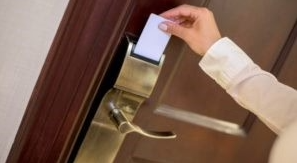We have all heard the annoying beep when someone tries to leave a store with a purchase that hasn’t had its security tag removed or deactivated. These are known as RFID tags, and these small devices create a lot of noise to prevent theft in stores.
Inside the tags are an electromagnetic strip and a semi-hard magnetic strip. Together, they convert magnetic field energy into mechanical vibrations. If not deactivated, this energy is detected by sensors at the retailer’s exit to trigger an alarm.

Another common security measure used by retailers is the magnetic lock latch. In this case, merchandise remains visible to shoppers but cannot be accessed without the magnetic key.
Both of these simple magnetic security methods help facilitate convenience for both buyers and sellers in managing merchandise.
Retail Security: Hard RFID Tags and Soft RFID Tags – offering various security options.
3. Magnetic Door Locks (Commonly Used in Hotels)
Due to their high security and safety features.
Each RFID card is electronically programmed with a unique pre-set information and stored in the lock’s memory. Each card has a unique and non-repeating code, different from any other card. To unlock the door, users must use the specific card that has the store data. Each person is assigned a specific RFID card.

4. Security Sensors
Door, window, and entryway sensors alert us to unauthorized access or notify us if a child has opened a door.

You might think that advanced technology controls these systems, but these security devices are actually just basic reed switches. Reed switches are simple electrical switches operated by the presence of a magnet.
In home security systems, removing the sensor from the magnetic field triggers an alarm. Because they are very sensitive to disruption, reed sensors generate alerts for potential hazards.
These are just a few examples of how magnets function to ensure safety and security. If you have another great application, please share it in the comments.





